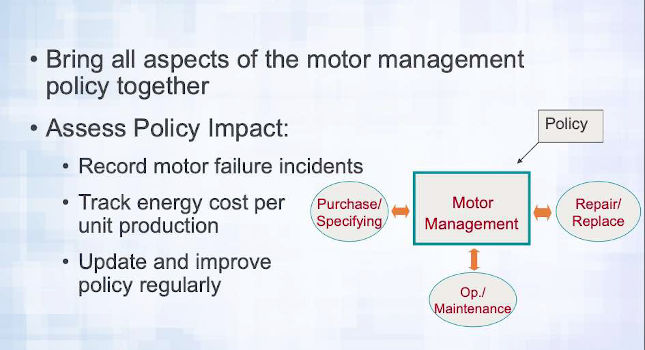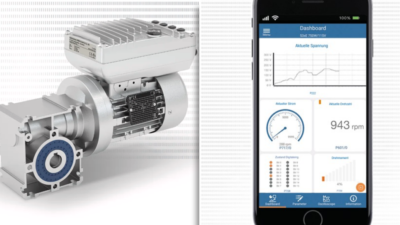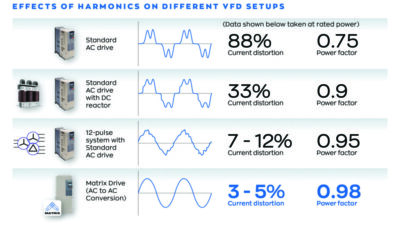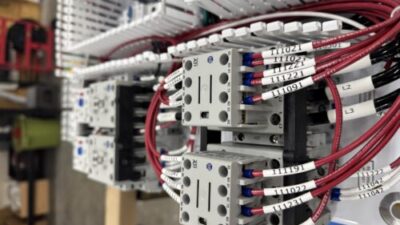Michael Lyda, motor and drive engineer with Advanced Energy Corp., explains tips and tools for efficient motor management in this transcript from a December 2020 webcast.

Michael Lyda, motor and drive engineer with Advanced Energy Corp., explains tips and tools for efficient motor management in this transcript from a December 2020. Part three focuses on motor management. This has been lightly edited for clarity.
Motor management advice for manufacturers
Courtesy: CFE Media, Advanced Energy Corp.[/caption]
What are the main components of a motor management system? There are three: purchasing, operations and maintenance, and lastly making the decision of repair versus replace.
Courtesy: CFE Media, Advanced Energy Corp.[/caption]
Come up with good guidelines for your three main components. For purchasing, develop purchase specifications. Normalize what brands you use. Specify model numbers. Consider lifecycle costs instead of only looking at initial costs. Purchase backups for your most critical machines. Build up a spares inventory. Follow the practices that we discussed earlier.
Perform routine maintenance on your motors. Focus more of your time on critical motors with high usage rates. For motor repair, you want to use repair shops that you trust. Now, I would also recommend using a certified repair shop. They should hold some sort of third-party quality repair accreditation. You can feel confident in the work that’s going on at the shop.
Just like for purchasing, develop motor repair specifications. If you’re using a certified shop, they can likely help you create a repair specification. If they won’t help you do that, you might want to find a different shop.
Courtesy: CFE Media, Advanced Energy Corp.[/caption]
Next, we’re going to dive a little deeper into each of the three components of the motor management system just described. Step one is to create your motor purchase policy.
Standardize your purchasing, which makes it easier to order the products you need, takes less time overall. Purchasing staff need to be professionally trained, initial cost isn’t the only factor in the equation. We saw from the example that initial cost has little impact on lifecycle cost. You may want to pre-qualify your vendors and in some cases, even perform testing. Our lab in Raleigh specializes in that.
Courtesy: CFE Media, Advanced Energy Corp.[/caption]
Let’s discuss motor repair, which is the third and final component of the good motor management system. Step one is to ensure your vendor is providing quality repairs. Similar to developing a purchase specification, you should develop a repair specification. You’ll see many items listed in the slides that can be added to your repair specs.
Courtesy: CFE Media, Advanced Energy Corp.[/caption]
Speaking of the quality repair motors, we have an example here showing what can happen when quality control procedures aren’t followed. This chart shows two performance curves for a 10 horsepower four-pole motor. Nameplate full load efficiency for the motor is 91%. We see the orange line, which shows efficiency when the motor was repaired, including bearing replacements with top-of-the-line motor bearings.
The bluish green line shows efficiency when the motor was repaired, including bearings that were of lower quality and not properly greased. You see quite the gap between the efficiency performance of both motors. It’s vital to make sure that your repair vendor is not making mistakes like this, or you’ll be losing money in electricity when you put these motors back into service.
Courtesy: CFE Media, Advanced Energy Corp.[/caption]
Repair vendors are happy to have your business and they’ll typically keep records for motors they’ve repaired or reconditioned for you, so they can be helpful in your management system tracking. Keep an open line of communication with your vendor. Once you have a motor management system in place, keep track of your motor failures and of energy costs versus production, you can use these numbers to update and improve your policy.
When you’re purchasing motors, use lifecycle costs instead of just initial cost. Develop and use purchase and repair specs so that you get the best motors for your application and the highest quality repairs. And finally, utilize strategic preventative maintenance techniques to upkeep your motor population and extend useful life.



